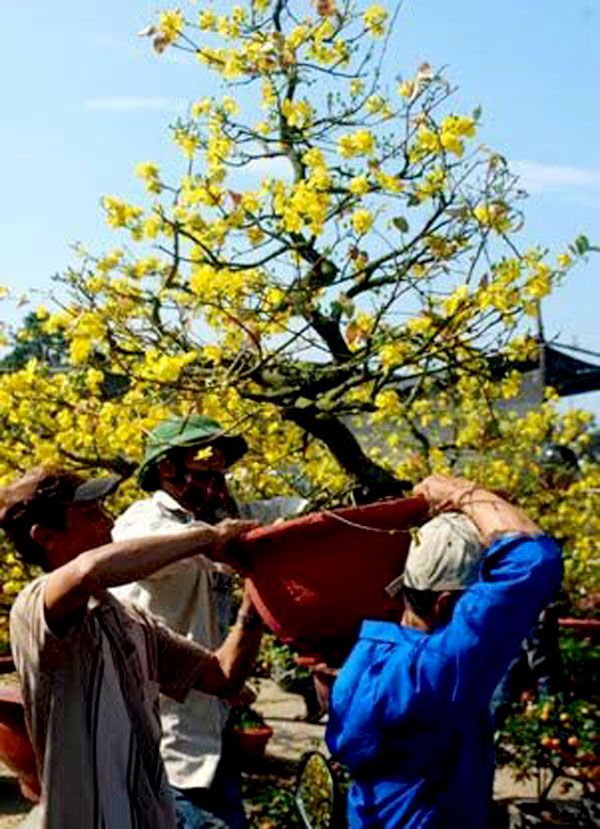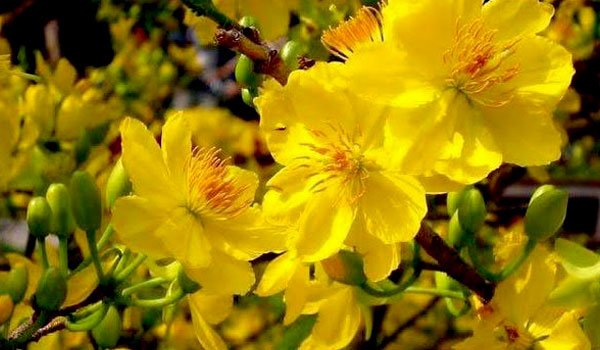In a large garden in the apricot blossom-growing village of Binh Loi in the city's rural Binh Chanh district, the bright-eyed man named Tran Duc told one of his customers who flied in from Hanoi that "You'd better order soon as our most beautiful apricot blossoms are selling like hot cakes and have almost run out, even though there are still two weeks until Tet (Lunar New Year Festival)."
During Tet, apricot blossoms are indispensable for Vietnamese families in the southern region as peach blossoms are in the northern region. Thanks to improved quality of life and more convenient transportation systems, more and more apricot blossoms are available in the north, while peach blossoms have migrated south in recent years.
"In our village alone, sales of apricot blossoms have surged more than 30 percent compared to the same period last year," Duc said, adding that he sells an average of 40 apricot trees a day, and as many as 200 trees in a single day.
The garden's owner attributed the rising sales to more beautiful apricot trees with more flowers, as well as reasonable prices. "This year's weather is milder, so the trees are blooming more, while their prices are a little bit lower than those of the trees grown in the neighboring Southeastern provinces or in the central region," he explained.

Wholesales prices of apricot trees in Duc's garden are increasing to a degree. A tree aged 3-4 years is sold for between 500,000 and 800,000 Vietnamese dong (22.2 and 35.5 U.S. dollars). Slightly older trees are priced at between 1 and 2 million Vietnamese dong (44.4 and 88.8 U.S. dollars).
"In recent years, many state organizations and enterprises and some well-off families haven't bought apricot trees, but rented them to display in their offices or villas during Tet. They often demand tall, big trees with branches laden with flowers and buds," Duc told Xinhua.
Beautiful, tall trees are dozens of years old, so renting such a tree during Tet costs between 30 and 70 million Vietnamese dong (1,333 and 3,111 U.S. dollars), he said,.
"Customers can choose their apricot blossoms via digital photos we send or by coming in person to our garden. We pledge to make trees bloom on the date customers receive them, and come to their offices or houses to take them back free of charge," Duc said, adding that his family has established a company named Mai Vang Binh Loi and opened a website to better serve customers nationwide.
In another apricot garden in Ho Chi Minh City's Thu Duc district, some occasional workers were plucking leaves so that the trees will bloom right before Tet.
"To date, half of our bigger trees in this garden have been rented, mainly by companies and restaurants. They want trees more than two meters in height and with many flowers, buds and some green leaves, which are believed to bring prosperity in the new year," a young woman wearing a facial mask and conical hat said, while plucking apricot leaves in the bright sunlight.

While apricot growers and traders in Ho Chi Minh City are poised to have a bumper crop due to favorable weather conditions, their peers in the central region are pulling wry faces.
In the central province of Binh Dinh, due to unexpected weather patterns with more unexpected sunny days, apricot trees are now in blossom, instead of shortly before Tet, or in the next two weeks.
Nhon An commune, An Nhon town, Binh Dinh province is considered to be one of the biggest apricot blossom hubs of the central region. Five out of six hamlets in the commune have been recognized as traditional apricot-growing villages. Out of 2,800 families in Nhon An, 2,400 grow apricot trees, which annually fetch them some 16 billion Vietnamese dong, according to the Binh Dinh Department of Agriculture and Rural Development.
Standing in the middle of his 3,000-tree garden in the commune, Le Du bemoaned, "This Tet, we planned to sell around 1,000 trees, but hundreds of trees have already blossomed. Few people buy apricot blossoms weeks before Tet, so we are dead sure to make losses this year."
The 34-year-old man said his family has poured about 100 million Vietnamese dong into growing the 3,000-tree garden since the beginning of this year. Suffering losses this Tet means that his family will find it hard to muster sufficient funding for growing apricot trees next Tet.
Another Nhon An villager named Nguyen Thi Thuan shares a similar plight. Her 700-tree garden now beams light yellow. "To slow down the bloom, I have added ice to the water I use for the trees, but too many have still blossomed before Tet. For us, this Tet is doomed," lamented the woman.

In early 2014, Vietnam had some 18,700 hectares of flowers and ornamental trees, including 9,500 hectares in the northern region and 9,200 hectares in the southern region, according to statistics from the Ministry of Agriculture and Rural Development. Local farmers on average annually gained 250 million Vietnamese dong from each hectare of flowers and ornamental trees.
Vietnam plans to have 22,000 hectares of flowers and ornamental trees by 2020, which translates to annual revenue of 50 million U.S. dollars, including export turnovers of some 100 million U.S. dollars.
- Tao Jun, Dong Hua
(Xinhua)






